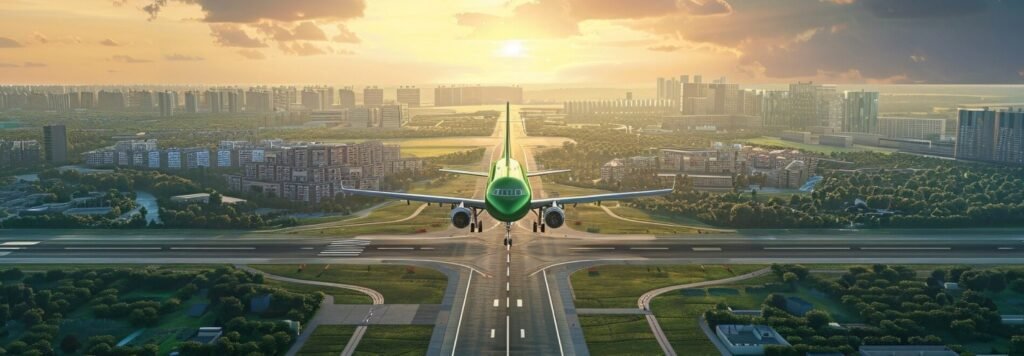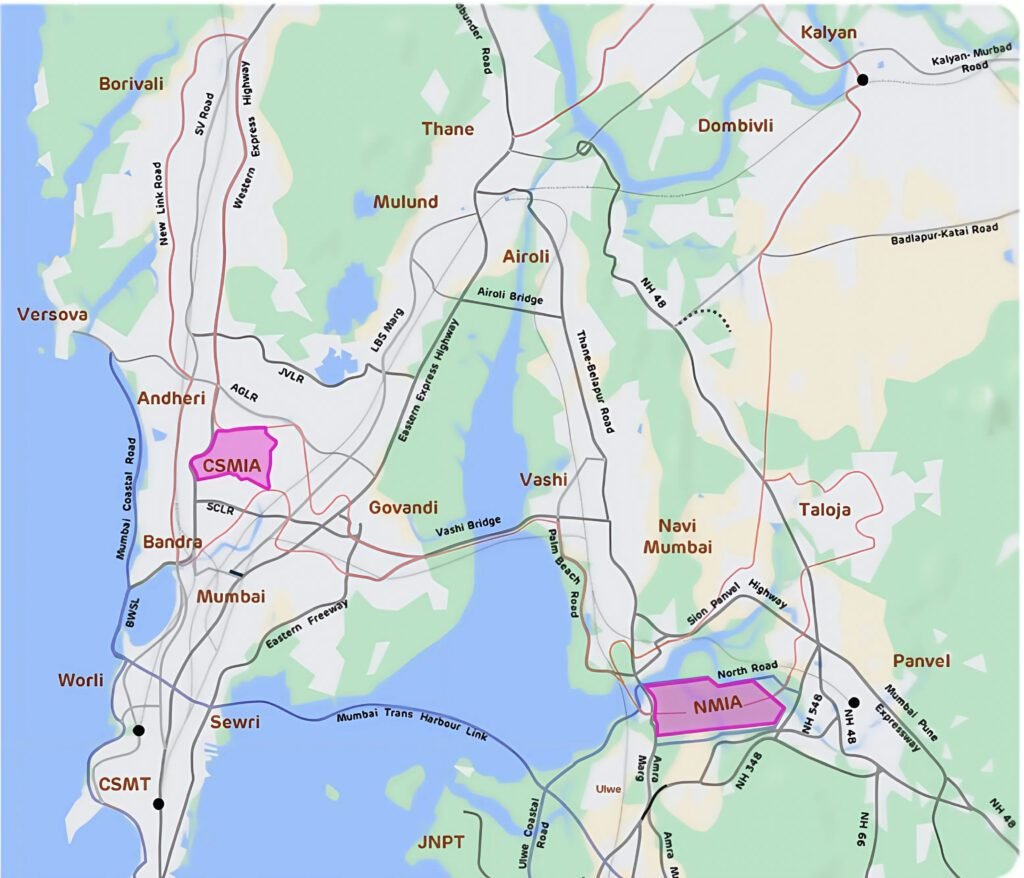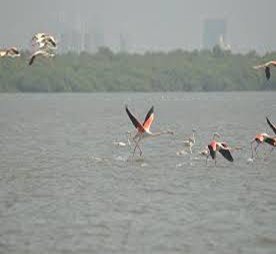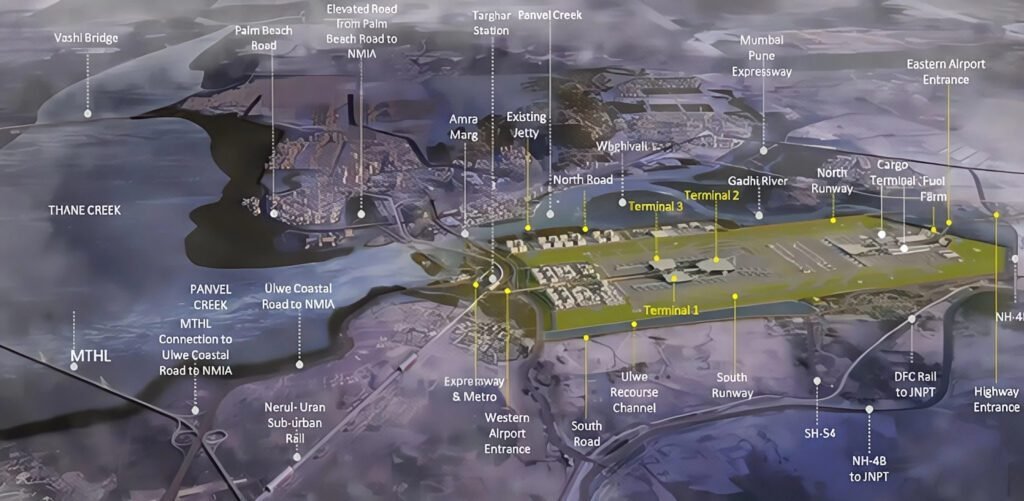After nearly three decades of anticipation, the Navi Mumbai International Airport (NMIA) is finally set to be inaugurated on October 2025. Spread across 1,160 hectares and costing ₹16,000 crore, the project promises to reshape India’s aviation map. Yet, as celebrations draw near, debates over its ecological and social costs remain unresolved.

Why NMIA Matters
Mumbai’s existing Chhatrapati Shivaji Maharaj International Airport (CSMIA) has long struggled with capacity limits, handling nearly 45 million passengers annually despite being designed for only 33 million (ACI Asia-Pacific, 2024). NMIA is expected to relieve this congestion dramatically, with a projected annual capacity of 90 million passengers and 2.5 million tonnes of cargo.
| CSMIA (Current) | NMIA (Planned) | |
| Annual capacity | 45M (designed for 33M) | 90M passengers |
| Cargo capacity | ~1M tonnes | 2.5M tonnes |
| Runways | 2 (cross) | 2 (parallel, simultaneous ops) |
| Terminal size | ~4.5M sq.ft. | 3 terminals (20M each) + 1 (30M) |
The airport will feature two parallel runways, three terminals with world-class amenities, and advanced design features aimed at sustainability (NMIA Official Website, 2025). For supporters, NMIA represents Mumbai’s long-overdue leap into global aviation competitiveness.

Environmental Costs
The project site lies within a 2,268-hectare zone of mangroves, wetlands, and mudflats—ecosystems vital for flood protection, carbon absorption, and fisheries. Construction has already destroyed over 100 hectares of mangroves and 400 hectares of mudflats (Geetha Ajit Pillai, 2023). To make way for the airport, a hill was flattened, two rivers diverted, and the land raised by 5–8 meters.

Environmentalists argue this amounts to “rewriting nature’s blueprint for short-term development.” Critics fear the ecological price will outweigh the economic gains, particularly as Mumbai faces climate risks and frequent flooding (The Times of India, 2023).
The Bird Strike Dilemma
Safety is another concern. The site lies along a major migratory route for birds, with 66 species identified, including flamingos, raptors, and waterbirds (Al Jazeera, 2023). Experts warn that NMIA could become prone to bird strikes, a grave aviation risk. The Bombay Natural History Society (BNHS) has been tasked with monitoring bird activity and recommending mitigation strategies, but doubts persist over the long-term safety of aircraft.


Promises of Resilience
CIDCO, the project’s nodal agency, defends the airport as an example of modern, climate-resilient infrastructure. Following studies by the Central Water & Power Research Station (CWPRS), the platform was elevated to +8m to withstand 100-year flood cycles and extreme rainfall events like the catastrophic 2005 Mumbai deluge (CWPRS, 2022).


Green initiatives include solar panels, electric vehicle infrastructure, rainwater harvesting, wastewater recycling, and designated mangrove buffer zones. Plans also envision adopting Sustainable Aviation Fuel (SAF) in the future (CIDCO, 2025). If executed fully, NMIA could emerge as one of India’s first green airports.
Human Displacement
Beyond the environment, the human cost has been heavy. The project required over 2,200 hectares of land, displacing nearly 3,500 families across Ulwe, Kopar, Ganeshpuri, and other villages (CIDCO, 2020). These communities, largely dependent on farming and fishing, lost both land and livelihoods.

CIDCO offered compensation packages, including cash payouts, developed land, and resettlement colonies. Yet, many families report that rehabilitation remains incomplete, with livelihood opportunities scarce (The Times of India, 2023). Activists argue that while the city gains world-class infrastructure, its traditional communities are left behind.

Connectivity and Infrastructure Gaps
Even as NMIA nears completion, supporting infrastructure lags behind. The Ulwe Coastal Road and western entry interchange have been delayed until 2026 (CIDCO, 2025). Public transport is limited: Kharkopar station is non-operational, metro projects remain on paper, and bus networks serve as temporary stopgaps.
Hotels and hospitality infrastructure are also sparse, with international chains yet to set up around the airport. Security planning is still underway, with only 285 immigration officers recruited so far. Such gaps raise questions about whether NMIA is truly ready for global-scale operations at launch.

Real Estate and Economic Impact
Supporters argue that NMIA will be an economic engine for the Mumbai Metropolitan Region (MMR). With expected passenger and cargo growth, the project could create lakhs of direct and indirect jobs (ACI Asia-Pacific, 2024).
Real estate prices in Navi Mumbai have already surged. Despite land acquisition disputes, areas like Ulwe and Panvel have become hotbeds of investment, with developers banking on the airport’s growth potential (99acres, 2025). For many, NMIA is not just an aviation project but a driver of regional urban expansion.
A Symbol of India’s Urban Paradox
The Navi Mumbai International Airport encapsulates India’s central urban dilemma: the push for global-standard infrastructure versus the cost of ecological and social displacement.
For optimists, NMIA signals India’s ambition and readiness to compete globally, boosting tourism, trade, and investment. For critics, it is a cautionary tale of environmental oversight and unequal development.
As the inauguration approaches soon, NMIA stands as both a symbol of modern India’s aspirations and a reminder of the fragile balance between growth and green. The world will watch to see whether it becomes a beacon of sustainable infrastructure—or a case study in the costs of unchecked development.
REFERENCES:
- ACI Asia-Pacific. (2024). Airport traffic projections for Asia-Pacific and the Middle East. Airports Council International.
- Al Jazeera. (2023, April 24). India’s new airport is unsafe due to bird-strike risk, activists say. Al Jazeera.
- CIDCO. (2020). Resettlement and rehabilitation report for Navi Mumbai International Airport project. City and Industrial Development Corporation of Maharashtra Ltd.
- CIDCO. (2025). Navi Mumbai International Airport infrastructure update. City and Industrial Development Corporation of Maharashtra Ltd.
- Construction World. (2025). Navi Mumbai International Airport to ease congestion at CSMIA. Construction World.
- CWPRS. (2022). Hydrological and flood safety study for Navi Mumbai International Airport. Central Water & Power Research Station, Pune.
- Geetha Ajit Pillai. (2023). Airport infrastructure resilience to climate change [Conference session]. City and Industrial Development Corporation of Maharashtra Ltd. (CIDCO).
- NMIA Official Website. (2025). Navi Mumbai International Airport project overview. The Times of India. (2023). Activists warn of ecological damage due to the Navi Mumbai airport. The Times of India.
- 99acres. (2025). Navi Mumbai real estate market report.
